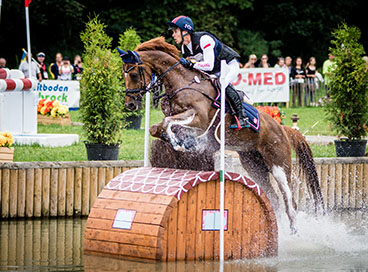By Agata Grosicka
Photography: Katarzyna Lichnowska and breeder’s private collection
His career began, however, when he worked for the State stud farms, and some 25 years ago he decided to establish and manage his own breeding centre. The stud farm is located in Bolkow, in the Lower Silesian district of Poland, right on German and Czech borders. Drabinski generally keeps fewer than 20 horses, and their offspring only remain until the age of three, when they are sold to new owners. He is very much a hands-on breeder, taking care of his horses himself with the help of only one or two grooms and assistants.

Q Why eventing horses?
I’ve always has a passion for showjumping, but jumping horses here do not really have that much potential to be noticed abroad. Polish eventing horses on the other hand are becoming more and more popular, even among top eventing riders. I’ve sold my horses to German, French and Italian clients, not to mention Polish ones. The German rider Andreas ‘Dibo’ Dibowski has bought a couple of my horses, including Belfast 35 (2010: Moravia [Westf] - Babilonia xx x Jape xx), and Adam Liedermann has bought two. Now is quite a good time for Polish eventing horses worldwide. Paweł Spisak and Banderas (2007: A full brother to Belfast 35) recently made their debut in Rolex Kentucky (CCI4*) as the first ever Polish couple, and finished 15th. Their performance was highly valued by both experts and the audience. (In March 2018 the pair finished second in the CIC3* Pratoni del Vivaro. To date, since their partnership began in 2013, they have recorded three victories, five times runners-up, and 10 top-10 finishes in international competitions. They also competed in the Rio 2016 Olympic Games but were eliminated during the cross-country.)
Both Banderas and Belfast represent Polish half-bred horses – the breed that was officially created and introduced during the 1990s as the modern breed of Polish sport horse. It was mostly local mares and foreign stallions that became the base for Polish half-breds: Sport horses with good prospects for jumping and, as it has turned out over the years, even better for eventing.
Q How would you describe your breeding?
Not very typical. Breeding always concentrates on good stallions which determine growth and development much faster than in the case of mares. It’s due to a very obvious fact. A good mare can give one foal while, at the same time, a good stallion can produce 50 good foals. I’ve been very fortunate to have Babilonia. She’s a Thoroughbred mare of quite unknown origins who has given birth to 16 fantastic foals over the years. She’s 22 now and retired, yet she’s still the queen of the whole herd. I have two young mare prospects at the moment...
CLICK HERE TO SUBSCRIBE TO BREEDING NEWS
SUBSCRIBERS CAN READ THE COMPLETE ARTICLE BY LOGGING IN AND RETURNING TO THIS PAGE





